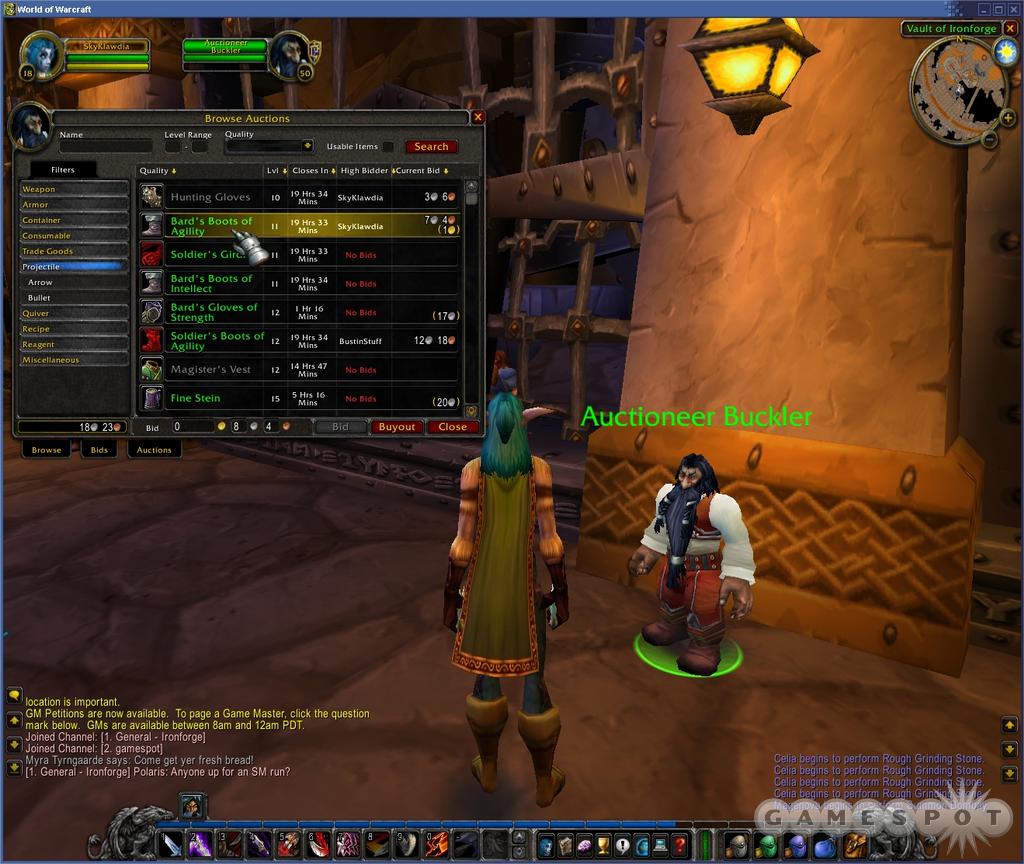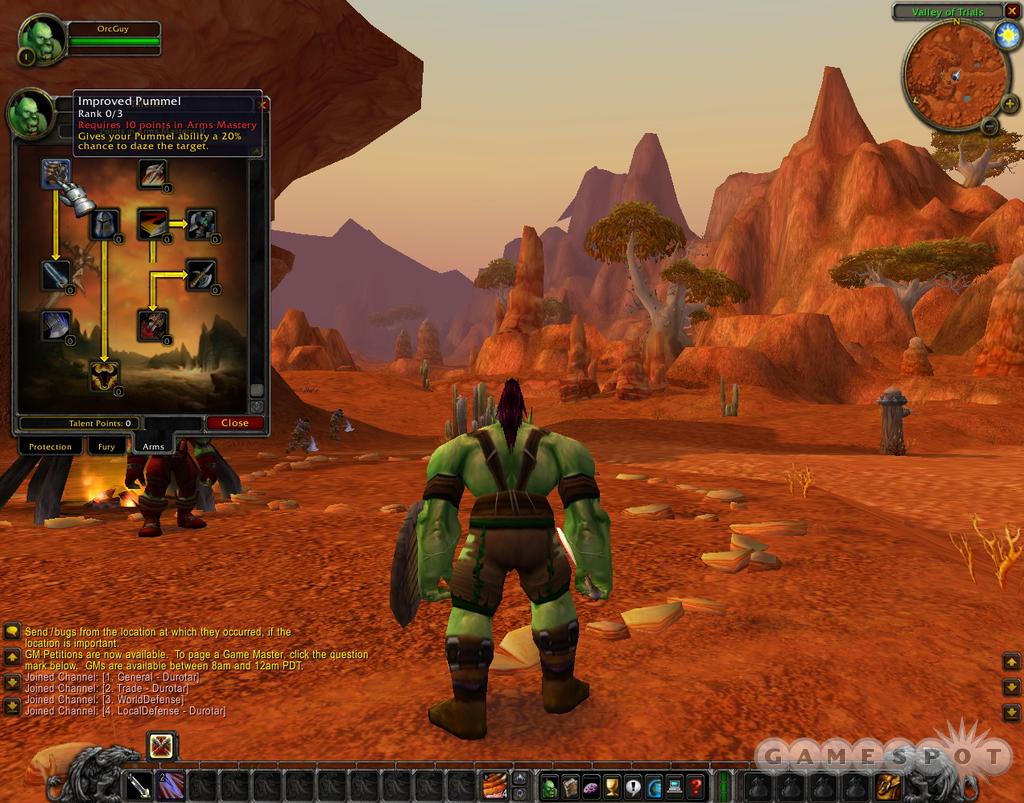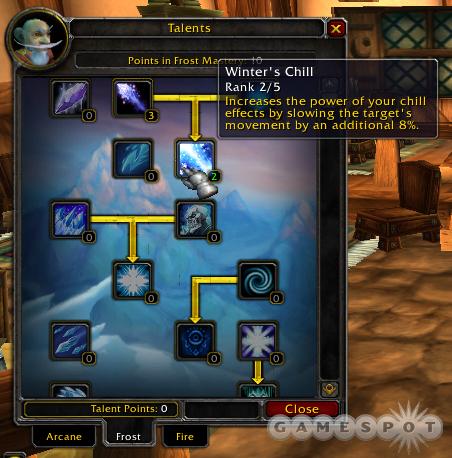World of Warcraft Updated Hands-On Impressions - The Talent System Returns
The upcoming massively multiplayer game World of Warcraft continues to evolve in its beta-test state to include character talents, auction houses, and more. Get the details here.
For some time now, massively multiplayer games have let players create their own characters to adventure in a persistent world alongside hundreds, even thousands, of other online players to fight monsters, acquire treasure, and gain experience levels. And for some time now, players have been awaiting the release of World of Warcraft, the online game that will take place in Blizzard's fantasy-themed Warcraft universe, which is populated with humans, elves, dwarves, orcs, and undead creatures, among others. The game is still in a beta-test state, and we've continued to follow its progress as a number of changes have been introduced recently. The new changes include both major and minor additions and tweaks.

Some of the minor changes are a new mouse-movement scheme and a revamped version of "rest state"--a system that grants "well-rested" players a bonus to the experience points they gain. The new system does not award bonus experience for players who have been playing the game for hours on end, but it does add a bonus for those that take a day or two off from playing the game--to simulate a way for "casual" players, who may not necessarily play the game every day, to still make decent progress with their characters. But note that these and other features are all subject to change because World of Warcraft is still being tested.
One of the more significant new features recently introduced to the game is auction houses, which have a very user-friendly, eBay-style interface. Auction houses seem to draw inspiration both from the auction houses of Square Enix's Final Fantasy XI and from the bazaar terminals of Star Wars Galaxies. You can list an item at auction for a nominal fee (based on how long you want the auction to last). Also like on eBay, you can set a buyout price if an impatient buyer wants the item immediately. You can even search for auctioned items using a host of parameters (such as category, level, and name) to find exactly what you're looking for. Once the auction is over, the winning bidders receive their bounty in the recently added in-game mailbox system.
Blizzard has also had the foresight to include a COD (cash on delivery) feature for the in-game mail. Thus, once your item arrives in the mail, you are required to pay the money in order to add the item to your inventory. Not only does this COD feature make sense in the context of an auction house, but it also allows players to easily barter items amongst themselves without too much coordination.

Much ballyhoo has also been made about the reimplementation of World of Warcraft's talents system, in large part because a rudimentary version of talents was included in (and then yanked from) the first version of the beta. Talents have finally made their triumphant return, and they're much more complex and customizable now. Essentially, a class has several ability hierarchies arranged in a tree format, similar to the skill tree featured in Blizzard's hack-and-slash action RPG Diablo II. There are three tabs, each with a separate set of talents that are designed to differentiate character classes (you gain one talent point per level, and each ability costs one point). Like in Diablo II, some abilities require you to reach a minimum level in a particular previous talent on the same path, while some will require a given level in more than one path. The mage, for instance, has talent trees for frost, fire, and arcane magic. Early level talents increase the range and effectiveness of your spells, for instance, while the later talents will provide entirely new (and seemingly very powerful) abilities.
A Talent for War
Since each class's talent layout requires a lot of balancing and fine-tuning, Blizzard has chosen to roll out talents for only mages and warriors in the latest World of Warcraft patch; talents for other characters will be coming soon. For instance, we've tried using the talent system to make a mage character much more powerful when adventuring solo. We were able to extend the range of both our frostbolt and fireball attack spells. Since the frostbolt spell makes enemies move much more slowly for a few seconds, we were able to use the talent-enhanced range to cast a frostbolt from well outside our enemies' attack ranges to slow them down, and then barrage them with fireballs to kill them before they could even get close enough to land a hit. However, focusing on fire and frost attack spells is just one way in which you can specialize; we could've put our talent points into arcane abilities and gained bonuses to our intellect skill, mana regeneration, and other such nuts-and-bolts elements instead.

We also had the opportunity to try out World of Warcraft's talent system for warriors. Warriors that wish to be better at being "tanks,"--that is, absorbing more damage and drawing enemies' attention away from teammates--seem like they should choose talents in the protection tree. But a warrior who often adventures alone may want to pick up talents in the arms tree to dish out more damage. The talent system seems to do a great job in distinguishing two characters of the same class, and it lets you tailor your character to your play style.
We created a warrior who focused on offense by putting 21 points into the arms tree, making him hit more often with his swords, deal more damage with two-handed weapons, and decrease the rage cost of "strike," a powerful ability that adds melee damage to your attack. Warriors continue to use a "rage" meter to execute different maneuvers in battle, though their meters empty out whenever they change to a different fighting stance (from a battle stance to a defensive stance, for instance), so the tactical mastery talent seems especially handy, as it lets you retain up to 15 rage points when switching stances.
We also dabbled with the fury tree, which makes warriors even more of a threat when sustaining damage and dealing out damaging random critical hits. The enrage talent gives you up to a 5-percent chance to become "enraged" when hit, which makes you deal more damage and attack faster. Cruelty improves your chances for a critical hit, and flurry will make your warrior attack faster when you land a critical hit. These three abilities tie together nicely, and they show how your talents can be complementary to each other. The protection talents aren't too bad either; for instance, combat endurance lets you regain health when in combat (something that characters don't normally do). The talent system appears to offer plenty of choices, so it seems like it will be a good idea to plan out your character's role in battle before you spend your talent points.

Other than talents and auction houses, World of Warcraft has also implemented various additional tweaks and changes to better balance player-versus-player combat and staging raids on enemy territory (now computer-controlled characters will call for the guards if attacked). In addition, the much-debated "sleep" spell (it originally appeared as a skill used by the dreadlord hero in Warcraft III), which was used by priest characters, was first moved to mages and is now unusable by any characters. Mages have instead received the polymorph spell, which longtime Warcraft III players should know transmutes enemies into harmless sheep for a period of time. Polymorph is functionally similar to sleep, but that hasn't stopped many beta testers from decrying this decision on the game's forums. The fate of the sleep spell is currently undecided, and it's practically guaranteed that many more such changes will occur as Blizzard continues to tweak the game before its projected year-end release. In the meantime, stay tuned to GameSpot for updates on this highly anticipated game.
Got a news tip or want to contact us directly? Email news@gamespot.com
Join the conversation